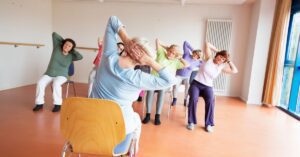The final weeks of summer carry a bittersweet quality, don’t they? For seniors in assisted living in New Berlin, WI, this seasonal shift can bring both nostalgia and uncertainty.
Seasonal transitions can feel particularly unsettling for older adults. Sleep patterns shift. Familiar routines suddenly feel off-balance. The shorter days ahead seem to whisper about changes that feel beyond our control.
Here’s what makes the difference: gentle awareness rather than forced relaxation. When you try too hard to relax, your body often rebels with more tension. Mindfulness offers a kinder path—simply noticing what’s happening right now with curiosity instead of judgment.
Creating a Calm Environment at Home
Your physical space shapes your emotional state more than you might realize. This connection becomes especially important for seniors in assisted living, where the environment directly influences daily comfort and peace of mind. When summer transitions to fall, reshaping your surroundings can provide the stability your mind craves during change.
Declutter and simplify your space
Clutter creates mental noise. Each misplaced item, every overcrowded surface sends a subtle signal to your brain that something needs attention. The result? A persistent low-level stress that interferes with relaxation.
The path forward doesn’t require a complete overhaul. Start with what feels manageable:
- Start small – Choose one drawer or shelf instead of tackling an entire room. That single completed task will give you momentum and a sense of accomplishment.
- Use the four-box method – Sort items into four clear categories: keep, donate, trash and relocate. This system works particularly well when you’re working with limited energy or space.
- Adopt the “one in, one out” rule – Each new item that enters your home means something similar leaves. This simple practice prevents the gradual accumulation that leads to overwhelm.
Add nature-inspired elements like plants or flowers
Nature has a remarkable ability to calm the human nervous system. Bringing natural elements indoors creates immediate peace while offering practical benefits for your health. Plants improve air quality, reducing stress levels in ways that artificial decorations simply cannot.
Some plants work especially well for seniors:
- Snake Plant (Sansevieria) – Releases oxygen at night, supporting better sleep while requiring almost no maintenance
- Peace Lily – Lives up to its name by purifying air and adding genuine tranquility to any room
- Lavender – The gentle fragrance naturally reduces stress and promotes relaxation
Sometimes the simplest additions make the biggest difference. Fresh flowers in a favorite vase or interesting branches from outside can transform a room’s energy completely.
Gentle Activities to Ease the Seasonal Shift
Movement doesn’t need to feel like work. For seniors, simple activities can become comfort anchors when the world feels uncertain. These practices honor your body’s current abilities while nurturing both physical and emotional well-being.
Light stretching or chair yoga
Your living room chair can become your wellness sanctuary. Chair yoga removes the intimidation factor that sometimes comes with traditional yoga classes—no special clothes, no complicated poses, no judgment about flexibility.
What happens when you practice regularly? The research tells a compelling story:
- Stress levels drop significantly, with cortisol decreasing after just 15 minutes
- Flexibility and balance improve when practiced twice weekly
- Concentration sharpens while anxiety fades
Start with what feels natural. Seated mountain pose grounds you. Gentle shoulder rolls release tension you didn’t know you were carrying. Seated spinal twists wake up your spine without strain. Your breath guides each movement—never force what doesn’t feel right.
Afternoon walks in nature
Something magical happens when you step outside. Maybe it’s the way sunlight filters through leaves or how fresh air fills your lungs differently than indoor air. Whatever the reason, nature walks offer medicine that comes without a prescription.
Two hours spent outdoors each week—that’s all it takes to significantly boost life satisfaction compared to staying indoors. Memory improves. Attention sharpens. Benefits that last well beyond the walk itself.
Creative hobbies like painting or knitting
Your hands remember more than you might think. Whether it’s the rhythm of knitting needles or the gentle stroke of a paintbrush, creative activities offer something unique—a chance to lose yourself in the present moment.
Knitting and crocheting create what is called a “meditative state” through their repetitive motions. Your nervous system settles. Worries fade into the background. Painting works differently but achieves similar results, pulling your focus away from stress and into the colors before you.
Listening to calming music or audiobooks
Some days, rest means sitting still and letting someone else do the work. Music has this remarkable ability to shift your mood almost instantly, actually lowering stress hormones like cortisol. Audiobooks offer the perfect companion for quiet afternoons—mental engagement without physical demands.
Your favorite chair becomes a portal to other worlds, other stories, other voices that remind you you’re not alone in this experience of growing older.
The seasonal transition feels less daunting when shared with others who understand the journey. To tour Heritage at Deer Creek and discover their approach to community connection, call (262) 789-6600.
FAQs
Q1. How can seniors make the most of the last days of summer?
Enjoy outdoor activities like gentle walks in nature, have picnics with loved ones or engage in light gardening. These activities can help seniors soak up the last bit of summer while preparing for the transition to fall.
Q2. What are some relaxation techniques for seniors as summer ends?
Seniors can try gentle stretching or chair yoga, practice deep breathing exercises, listen to calming music or enjoy warm baths. These techniques can help ease the transition between seasons and promote overall relaxation.
Q3. How can seniors create a calming environment at home during seasonal changes?
Declutter living spaces, use soft lighting and calming colors and add nature-inspired elements like plants or flowers. These changes can help create a peaceful atmosphere that supports relaxation during seasonal transitions.


